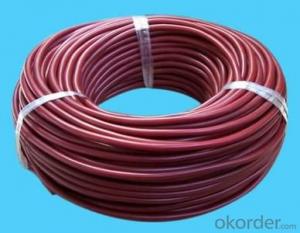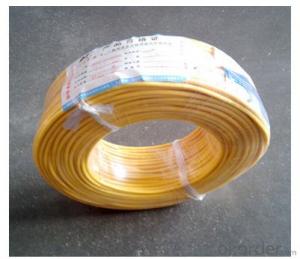Fe- CuNi(Constantan) thermocouple (Type J) A quality
- Loading Port:
- Shanghai
- Payment Terms:
- TT OR LC
- Min Order Qty:
- 100000 m
- Supply Capability:
- 1000000 m/month
OKorder Service Pledge
OKorder Financial Service
You Might Also Like
Fe-CuNi thermocouple (type J) is also named Fe- Constantan thermocouple. The positive leg Fe(JP) is made by pure Iron, and the main chemical composition of negative leg Constantan (JN) is Cu: Ni≈ 55%: 45%. Although they are all called Constantan, JN does not give the same EMF output curve as EN and TN, it cannot be instead by other Constantan.
The operating temperature range of type J thermocouple is -210~1200℃, but it is usually used in the temperature range 0~750℃ due to embrittlement of Iron.
Type J thermocouple has good resistance to oxidation and high EMF output against Platinum 67, with good temperature accuracy, sensitivity and stability. It is recommended for vacuum, oxidizing, reducing or inert atmospheres, but it can not be used in sulphurous atmosphere above 500℃.
- Q: I love squirrels, but they nibble at everything, which includes the electrical wires. I don?t want to cause them any harm but is there a way to make them go away? I tried to make it difficult to climb up the house but they are experts at it
- I think the danger is to the squirrels and not the electrical wires. You will have to set one or more traps and haul the rats with bushy tails away to a nearby park or someone on the other side of town you dislike, and release them so they can't find their way back.
- Q: If you are looking at an automotive electrical wiring chart what symbols would be used to represent the wiring of (1) a throttle actuator (2) a step up coil (3) reed switches (4) a seperate ECU cruise control circuit. In other words, what type of wiring would it be classified as, so that I can find it on a wiring chart? Thanks!
- this is really hard to explain over the internet. send me an email at my address listed below and i will send you an electrical diagram key. also please state year, make and model.
- Q: Will the total electricity is 3000W, how much square copper to use, the calculation method is? The The The Thank you!
- Can buy a TV box. Satellite connected to the antenna to connect the TV box, the TV box can even the computer! It 's not so much trouble at all in terms of speed, and it' s just as hard as you can.
- Q: The socket has yellow and blue gray three colors, which is the line of fire? Which is the zero line? Which is the ground?
- Cpu with Intel e6600 what the motherboard on the use of medium can best find an acquaintance there is the kind of quotient or the business is easy to kill people
- Q: What is the difference between YC and YZ cable?
- Most of the current use of CPVC, PVC as the base material, into other polymer materials to improve the high toughness of the high-voltage power cable sheathing. Mainly used for cable laying to guide and protect the cable when the role.
- Q: Hi everyone.We moved in a new house (not an appartment). The basement is finished. I am not usually be down there yet, so I can say it is not in use. I turned the separately partial heater down to 50 F degrees. The basement has some problem, the electric down there seems not steady. When I turn the neon lights on, it keeps blinking for the first 30 seconds. When I touch the switchers, it shocks me a little bit.For addition, my house is like 1600 square feet, 2 bed rooms, 1.5 baths. I keep the central air heater (pretty new, 2009) at 78 F degrees, and the electric bill first month came at $288 saying I used 2606 kWh for 20 days. I doubt that my basement's electrical wiring set-up is broken somewhere, so the electric leaks or wastes somehow.Questions are: Is it the first bill $288 for my house size weird? How do I test if my electrical wire set-up is not wasting my money?Thanks everyone.
- Do you have any electric heaters? The electricity is not leaking. If you have an electical leak, it is not the same as a water leak. An electrical leak will not increase your electicial bill noticeably. It will trip a breaker, blow a fuse, or cause a fire. You keep the basement at 50 degrees. this is likely the reason your neon (fluorescent lights) flicker before coming on. Fluorescent bulbs often will flicker or glow when the are cold and/or damp. If your house is noew the electrical boxes should be proerly grounded. As for the electrical shocks, they could be static electricity discharging to the grounded electrical boxes. If you are not sure, hire a reputable qualified electrician to check this out. If your house is new; keep any bills and present them to the builder only if there a fault was found in the wiring.
- Q: A two-color air-conditioning, a 1.5P air-conditioning, two TV sets, a water heater, a Yuba, a hood, a washing machine, a refrigerator, there are some normal use of lights and other appliances, housing area is 85 square meters (The actual use of the area is 70 square meters), I would like to ask how many holes in the wall of the single-strand copper wire, about how many meters, thank you!
- Household wire is BV model, air conditioner socket selection BV-3X4mm2 wire; then an air switch 20A alone plus a leakage protector. The kitchen socket with a way BV-3X4mm2 wire; then an air switch 20A can be shared with the bathroom leakage protector. Toilet outlet also with a way BV-3X4mm2 wire; then an air switch 20A can share the leakage protector. Other sockets with a way BV-3X2.5mm2 wire; then an air switch 16A can be shared with the bathroom leakage protector. Lighting with one or two BV-2X2.5mm2 wire; then an air switch 16A. Note: According to the provisions of the country's residential, 1.5mm2 wire is prohibited to use, so can not use 1.5mm2 wire, must use 2.5mm2 and above specifications. Even if your home only a 3W bulb must also use 2.5mm2 wire and can not use 1.5mm2. BV-4mm2 wire about 120 meters, BV-2.5mm2 wire about 150 meters.Note: the wire to be based on your home room to set, and now there is no plan can only report a approximate number for reference. Such as the bathroom and the kitchen far from the door do not know how long the wire is not out. Air conditioner installed in the location where do not know, on the left or the right side of the wire should be several meters worse. Lighting switch on which position, the same difference between the wire a few meters, and so on, so this figure is no way to report, for your reference, not a few.
- Q: I have a back patio light that is obsolete now that I added a covered porch. Could I add an electrical box, attach additional wiring, run it through conduit and ultimately attach it to a ceiling fan in the overhead patio area? (from the point from where the wiring attaches to the original light)
- Yes it is , but do not hide the box. you must be able to see and open all boxs after the the job is done.
- Q: I had drywall replaced in my kitchen ceiling behind a light fixture due to some water damage. The worker disconnected the wires from the light fixture and took it down without labeling anything. I have no idea how to reconnect the wires. In the ceiling there are two white wires that are twisted. Then there is a black wire and a white wire that are twisted together. On the light fixture itself, there are two white wires and two black wires all separate. What connects to what? Please help if you are experienced with this sort of thing. Thanks. I don't want to ruin the light or shock myself.
- In the ceiling box, you only described two sets of wires, a twisted set of whites and a twisted set of black and white. Is that all that is in the ceiling box? I have got to disagree with Victor. The black and white twisted together usually indicates what we call a switch leg. Need more info on the wires in the box.
- Q: 30kw how much cable and switch to use
- Current 50A wire VV or YJV223 * 10 + 1 (30 meters) switch 100A (consider starting current)
Send your message to us
Fe- CuNi(Constantan) thermocouple (Type J) A quality
- Loading Port:
- Shanghai
- Payment Terms:
- TT OR LC
- Min Order Qty:
- 100000 m
- Supply Capability:
- 1000000 m/month
OKorder Service Pledge
OKorder Financial Service
Similar products
Hot products
Hot Searches





















